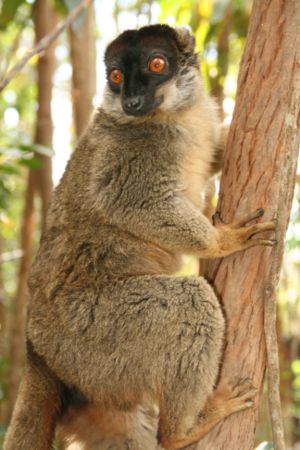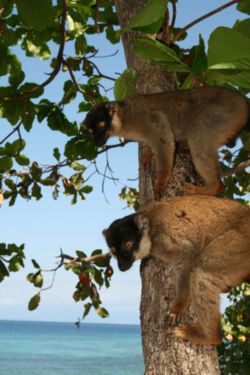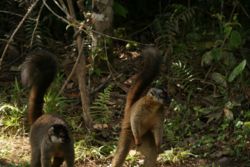Common brown lemur: Difference between revisions
imported>Lee R. Berger (adding subpages) |
mNo edit summary |
||
| (7 intermediate revisions by 5 users not shown) | |||
| Line 1: | Line 1: | ||
{{ | {{subpages}} | ||
{{Image|Brown lemur2.jpg|right|300px|A '''Common brown lemur''', (''Eulemur fulvus'').}} | |||
The '''Common brown lemur''' ''Eulemur fulvus'' is a medium-sized quadrupedal [[Lemur]]. In the wild, it is found only on the island of [[Madagascar]], some smaller islands off the coast and the island of Mayotte in the Comores. | The '''Common brown lemur''' ''Eulemur fulvus'' is a medium-sized quadrupedal [[Lemur]]. In the wild, it is found only on the island of [[Madagascar]], some smaller islands off the coast and the island of Mayotte in the Comores. | ||
==Description== | ==Description== | ||
{{Image|brown lemurs.jpg|left|250px|Two male brown lemurs near the island of Nosy Be.}} | |||
The common brown lemur is a diurnal [[Primate]] that has a head body length of approximately 43 – 50 cm and a tail length of around 41-51 cm<ref name="Fleagle">{{cite book|title=Primate Adaptation and Evolution|accessdate=|author=J. Fleagle|authorlink= |coauthors= |date=1998 |format= |work= |publisher=Academic Press: New York|pages= |language= |archiveurl= |archivedate= |quote= }}</ref><ref name="Szalay">{{cite book |title=Evolutionary History of the Primates|accessdate=|author=F. Szalay and E. Delson|authorlink= |coauthors= |date=2001 |format= |work= |publisher=Academic Press, New York|pages= |language= |archiveurl= |archivedate= |quote= }}</ref><ref name="Mittermeier">{{cite book|title=Lemurs of Madagascar|accessdate=|author=Mittermeier et al.|authorlink= |coauthors= |date=2006 |format= |work= |publisher=Conservation International|pages= |language= |archiveurl= |archivedate= |quote= }}</ref>. Weight ranges between approximately 3 and 3.5 kg<ref name= "Mittermeier"/>. Coat color is brown to grey brown on the back while the ventral coat is paler <ref name= "Mittermeier"/>. The face, muzzle and top of the head are typically black while the beard tends to be lighter <ref name= "Mittermeier"/>. Patches of light fur above the eyes are not uncommen. In the northern part of the range and on the island of Mayotte some animals exhibit larger light patches over and around the eyes. There are no size or color differences that distinguish males from females. | The common brown lemur is a diurnal [[Primate]] that has a head body length of approximately 43 – 50 cm and a tail length of around 41-51 cm<ref name="Fleagle">{{cite book|title=Primate Adaptation and Evolution|accessdate=|author=J. Fleagle|authorlink= |coauthors= |date=1998 |format= |work= |publisher=Academic Press: New York|pages= |language= |archiveurl= |archivedate= |quote= }}</ref><ref name="Szalay">{{cite book |title=Evolutionary History of the Primates|accessdate=|author=F. Szalay and E. Delson|authorlink= |coauthors= |date=2001 |format= |work= |publisher=Academic Press, New York|pages= |language= |archiveurl= |archivedate= |quote= }}</ref><ref name="Mittermeier">{{cite book|title=Lemurs of Madagascar|accessdate=|author=Mittermeier et al.|authorlink= |coauthors= |date=2006 |format= |work= |publisher=Conservation International|pages= |language= |archiveurl= |archivedate= |quote= }}</ref>. Weight ranges between approximately 3 and 3.5 kg<ref name= "Mittermeier"/>. Coat color is brown to grey brown on the back while the ventral coat is paler <ref name= "Mittermeier"/>. The face, muzzle and top of the head are typically black while the beard tends to be lighter <ref name= "Mittermeier"/>. Patches of light fur above the eyes are not uncommen. In the northern part of the range and on the island of Mayotte some animals exhibit larger light patches over and around the eyes. There are no size or color differences that distinguish males from females. | ||
==Behaviour== | ==Behaviour== | ||
| Line 15: | Line 15: | ||
==Geographical distribution== | ==Geographical distribution== | ||
The common brown lemur may be found | The common brown lemur may be found throughout western Madagascar north of the Betsiboko River, in scattered forest fragments in eastern madagascar, to the north on islands around Nosy Be and on the island of Mayotte in the Comores<ref name= "Mittermeier"/>.{{Image|mayotte form.jpg|right|250px| Two color variants of the brown lemur - the Mayotte form on the right and the more common color variant on the left.}} | ||
| Line 21: | Line 21: | ||
The common brown lemur is considered to be vulnerable by the IUCN. | The common brown lemur is considered to be vulnerable by the IUCN. | ||
==References== | ==References== | ||
{{reflist}} | {{reflist}}[[Category:Suggestion Bot Tag]] | ||
[[Category: | |||
Latest revision as of 06:00, 31 July 2024
The Common brown lemur Eulemur fulvus is a medium-sized quadrupedal Lemur. In the wild, it is found only on the island of Madagascar, some smaller islands off the coast and the island of Mayotte in the Comores.
Description
The common brown lemur is a diurnal Primate that has a head body length of approximately 43 – 50 cm and a tail length of around 41-51 cm[1][2][3]. Weight ranges between approximately 3 and 3.5 kg[3]. Coat color is brown to grey brown on the back while the ventral coat is paler [3]. The face, muzzle and top of the head are typically black while the beard tends to be lighter [3]. Patches of light fur above the eyes are not uncommen. In the northern part of the range and on the island of Mayotte some animals exhibit larger light patches over and around the eyes. There are no size or color differences that distinguish males from females.
Behaviour
Group size varies between 3 and 12[2][3]. The common brown lemur moves mostly quadrupedally but is also a reasonably adept leaper[3].
Diet
The common brown lemur is frugiverous but also eats young leaves and flowers [2][3].
Geographical distribution
The common brown lemur may be found throughout western Madagascar north of the Betsiboko River, in scattered forest fragments in eastern madagascar, to the north on islands around Nosy Be and on the island of Mayotte in the Comores[3].
Status
The common brown lemur is considered to be vulnerable by the IUCN.
References
- ↑ J. Fleagle (1998). Primate Adaptation and Evolution. Academic Press: New York.
- ↑ 2.0 2.1 2.2 F. Szalay and E. Delson (2001). Evolutionary History of the Primates. Academic Press, New York.
- ↑ 3.0 3.1 3.2 3.3 3.4 3.5 3.6 3.7 Mittermeier et al. (2006). Lemurs of Madagascar. Conservation International.


